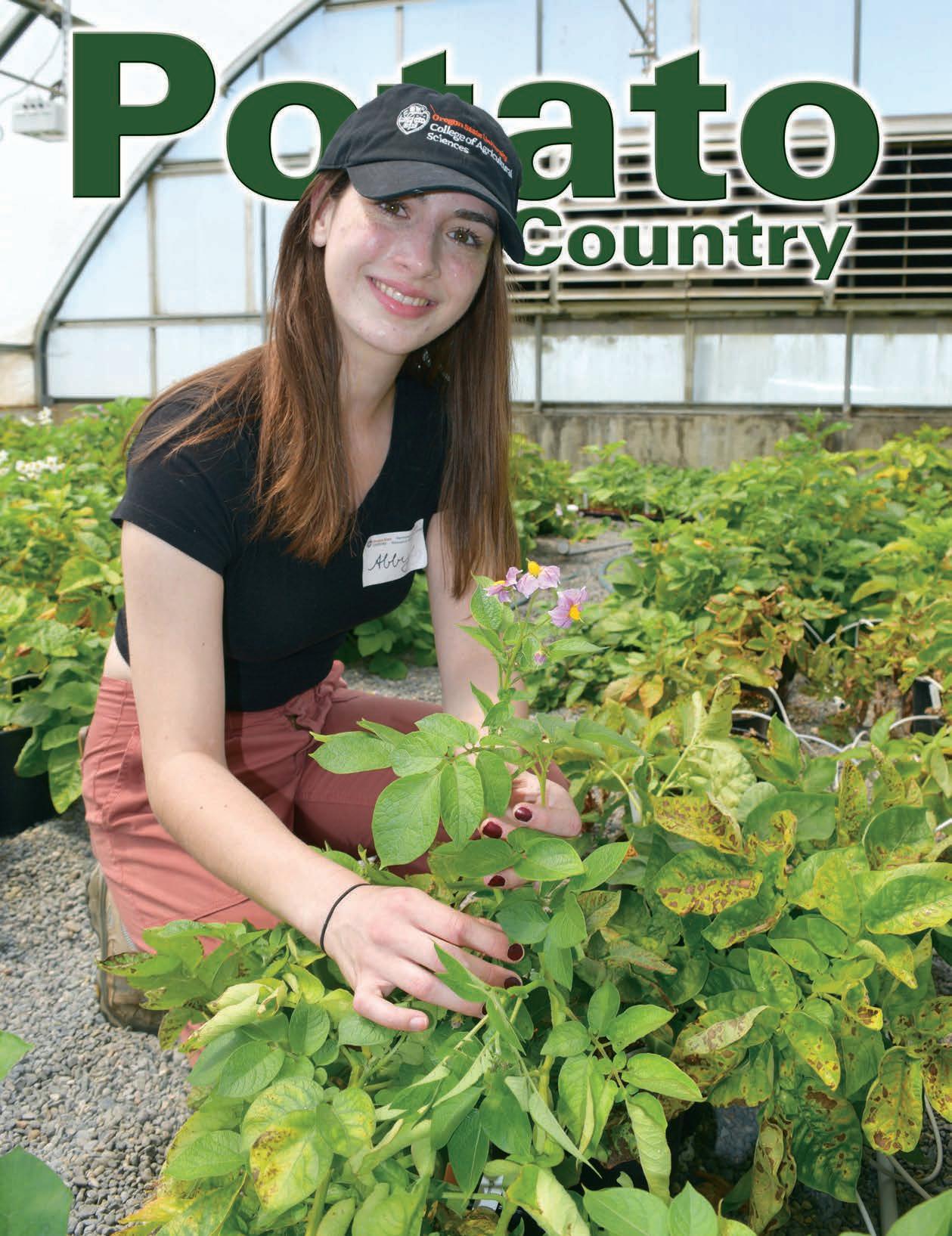

PLUS: • Fertilizer Market • Storage Essentials • Improving Irrigation Efficiency • Growers Expand Potato Acreage OSU Field Day A DUO OF DISEASES PotatoCountry.com • September/October 2023 Western focus. National impact. Agri-Stor ........................3 Bayer .............................5 Colorado Seed ...............18 Greentronics..................14 Industrial Ventilation .....32 Lake Seed ......................23 Montana Seed ...............16 Montana Seed Seminar .11 NovaSource ...................17 NovaSource ...................19 Potato Expo ...................31 Redox ............................13 R&H Machine ................25 Skone Irrigation .............28 SpudEquip.com .............11 Stukenholtz ...................29 Titan Steel .....................24 Telone ...........................2 Verbruggen....................27 ADVERTISER INDEX




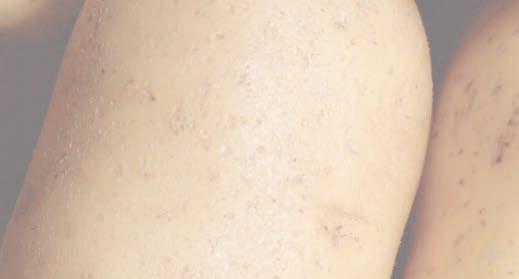


TELONE™ II is the world's best defense against destructive plant parasitic nematodes, including root-knot, root-lesion, and stubby-root. Applying TELONE™ before planting leads to healthier roots, higher yields, and improved quality. A custom blend of TELONE™ (to combat nematodes) and chloropicrin (to target soil-borne diseases like fusarium wilt and scab) is an effective one-two punch for all of your potato needs. www.TeleosAg.com Contact your TELONE™ Specialist to learn how TELONE™ can set you up for a successful growing season. LET US HANDLE THE NEMATODES SO YOU CAN HANDLE EVERYTHING ELSE. TELONE™ is a Trademark of the Dow Chemical Company (“Dow”) or an affiliated company of Dow, used under license. TELONE™ is a federally Restricted Use Pesticide. Always read and follow label directions. REMEMBER, THERE'S NO COMING BACK FROM A POOR START! POTATOES GROWN IN NON-FUMIGATED SOIL POTATOES GROWN IN SOIL TREATED WITH TELONE™ & CHLOROPICRIN
The active ingredient is a naturally occurring molecule commonly found in many foods such as yogurt, fermented soy, ham, tuna, mushrooms, and other foods and spices.
It is approved for use as a direct food additive in foods such as beverages and baked goods in many parts of the world including Europe, North America, and Japan.
SmartBlock is synthesized but identical to the natural substance.
In extensive tests conducted around the world, SmartBlock has been found to be highly efficacious for providing excellent sprout control on many potato varieties.

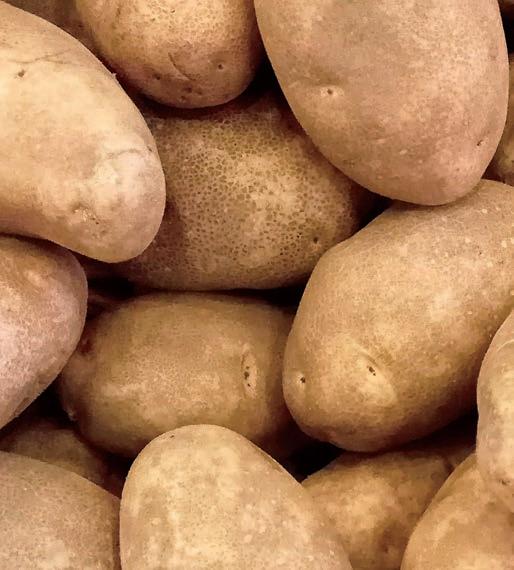
It works under varied storage conditions.
Ideal for short and long-term potato sprout control.
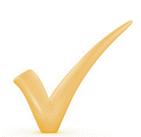


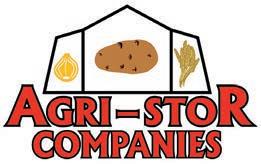
Acts exclusively on the rapidly growing meristematic sprout tissue.
Soon after treatment, tuber respiration increases, which rapidly metabolizes reducing sugars. SmartBlock restores fry color and dormancy to potatoes.
Within 1 to 4 days posttreatment, small to medium sprouts present a burned-out appearance. Longer sprouts may take 7 to 10 days to fully blacken.
www.agri-stor.com Warden Tri-Cities 509.349.7000 Twin Falls 208.733.7000 WASHINGTON COLORADO Blackfoot 208.785.7000
NATURAL EFFECTIVE UNIQUE MODE OF ACTION
Monte Vista 719.850.3017 Trust your harvest to Agri-Stor.
IDAHO
IDAHO What is Smartblock?
PO Box 333, Roberts, Idaho 83444
Telephone: (208) 520-6461
Circulation: (503) 724-3581
PotatoCountry.com
EDITOR
Denise Keller editor@ColumbiaMediaGroup.com

OPERATIONS MANAGER, ADVERTISING

Brian Feist brian@ColumbiaMediaGroup.com
PUBLISHER, ADVERTISING

Dave Alexander dave@ColumbiaMediaGroup.com
INSECT IDENTIFICATION
Andy Jensen www.nwpotatoresearch.com
DISEASE IDENTIFICATION
Jeff Miller jeff@millerresearch.com




MARKET REPORT
Ben Eborn napmn@napmn.com
POTATO GROWERS OF WASHINGTON
Dale Lathim dale@pgw.net
EDITORIAL INFORMATION
Potato Country is interested in newsworthy material related to potato production and marketing. Contributions from all segments of the industry are welcome. Submit news releases, new product submissions, stories and photos via email to: editor@ColumbiaMediaGroup.com.

ADVERTISING SALES
For information about advertising rates, mechanics, deadlines, etc., call (208) 520-6461 or email dave@PotatoCountry.com.
SUBSCRIPTIONS
U.S. $24 per year / Canada $40 per year / Foreign $80 per year Subscriptions can be entered online at: potatocountry.com/subscribe or call (503) 724-3581. Email address changes/corrections to: brian@ColumbiaMediaGroup.com or send to
Potato Country, PO Box 333, Roberts, ID 83444. Potato Country magazine (ISSN 0886-4780), is published eight times per year and mailed under a standard rate mailing permit at Idaho Falls, Idaho and at additional mailing offices. It is produced by: Columbia Media Group, PO Box 333, Roberts, ID 83444
Copyright 2023. All rights reserved. No part of this publication may be reproduced or transmitted in any form or by any means, electronic or mechanical, for any purpose without the express written permission of Columbia Media Group.
4 Potato Country • September/October 2023
Gary Roth Executive Director Oregon Potato Commission (503) 239-4763 Jamey Higham President/CEO Idaho Potato Commission (208) 334-2350 Nina Zidack Director Montana Seed Potato Certification (406) 994-3150 Jim Ehrlich President/CEO Colorado Potato Commission (719) 852-3322 EDITORIAL BOARD Country Western focus. National impact. Vol. 39 No. 6 SEPTEMBER/OCTOBER 2023 9 Insect Quiz 10 Disease Quiz 19 Calendar 23 In the News 26 New Products 30 PGW Column 30 Advertiser Index Foodservice importers and retailers tour a potato farm during a reverse trade mission. Read more about Potatoes USA's international marketing efforts on page 24. Graduate student Abigail Moore works in a greenhouse at Oregon State University, where she is researching powdery scab resistance. Read about her work on page 6. TABLE OF CONTENTS Chris Voigt Executive Director Washington State Potato Commission (509) 765-8845 ON THE COVERDEPARTMENTS 6 A Duo of Diseases: Powdery Scab and Potato Mop Top OSU Potato Field Day 12 Improving Irrigation Efficiency WSU Potato Field Day 18 Four Steps to Managing a Volatile Fertilizer Market 20 Storage Essentials Buyers' Guide 24 International Marketing Efforts Build LongTerm Global Demand for US Potatoes Potatoes USA 28 North American Growers Expand Potato Acreage Market Report
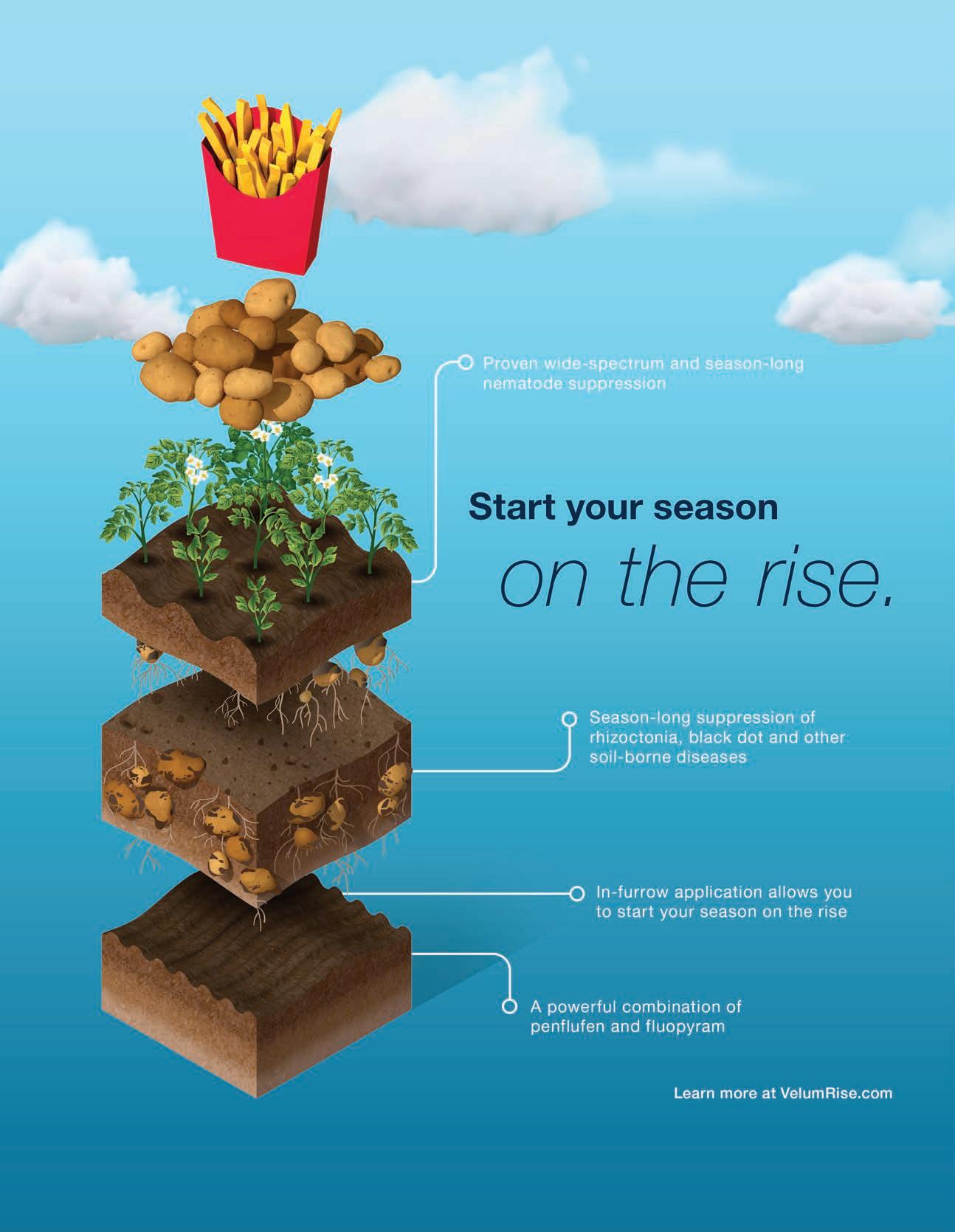
ALWAYS READ AND FOLLOW PESTICIDE LABEL DIRECTIONS. Not all products are registered for use in all states and may be subject to use restrictions. The distribution, sale, or use of an unregistered pesticide is a violation of federal and/or state law and is strictly prohibited. Check with your local dealer or representative for the product registration status in your state. Bayer, Bayer Cross, and Velum ® are registered trademarks of Bayer Group. For additional product information, call toll-free 1-866-99-BAYER (1-866-992-2937) or visit our website at www.BayerCropScience.us. Bayer CropScience LP, 800 North Lindbergh Boulevard, St. Louis, MO 63167. ©2023 Bayer Group. All rights reserved.
A Duo of Diseases: Powdery Scab and Potato Mop Top
Story and photos by Denise Keller, Editor
In a series of presentations about powdery scab at the Oregon State University (OSU) Potato Field Day, one speaker said the pathogen that causes the disease is estimated to be in 80 percent of the fields in the Columbia Basin. Another presenter mentioned that she brought samples of infected tubers for growers lucky enough to have never seen it in their fields.
The widespread nature of powdery scab is one reason researchers are focusing on the disease. But in addition, its causal agent also vectors potato mop top virus, which can be a larger concern and is becoming more prevalent.
Concerns and Questions
Ken Frost, an OSU plant pathologist, set up the series of talks with an overview of diseases he is seeing in area potatoes, including powdery scab. The disease, which is caused by Spongospora subterranea, results in root galling and lesions on the tuber surface. The tuber blemishes can prove particularly problematic in potatoes grown for the fresh market.
The pathogen is spread through infested soil and infested or infected seed. Cooler temperatures and moist soil conditions are conducive for disease development, with spores germinating
Powdery scab can result in scab lesions on the surface of tubers.

at around 50 degrees Fahrenheit and soil temperatures of 53 to 63 degrees Fahrenheit being optimal for tuber infection.
No chemical or biological treatment fully suppresses powdery scab. Therefore, it is recommended to start with pathogen-free planting materials and to avoid planting in infested fields, planting in poorly drained soils, and using excessive nitrogen fertilization. In addition, it is recommended that growers sanitize equipment when moving between infested fields.
The pathogen that causes powdery scab is also a vector of potato mop top
virus. Potato mop top results in tuber necrosis in some cases, ultimately reducing potato processing value. Potato mop top virus is becoming more prevalent and traveling in seed, Frost said, estimating that the virus is in 3 to 10 percent of the seed lots entering the Columbia Basin. The virus infection is often asymptomatic and although the resulting crop will probably have the virus, tubers may or may not become symptomatic. There is environmental variability associated with potato mop top virus infection and symptom expression, and more research is needed to determine the conditions that will result in tuber necrosis.

It is unclear how much acreage is currently infested with Spongospora subterranea that is able to transmit potato mop top virus. Researchers are also unsure how often the pathogen can acquire mop top virus from infected seed planted in a field. If Spongospora subterranea readily acquires the virus from infected seed, it could mean that potato mop top virus could be rapidly increasing in prevalence and has the potential to be present in the field for long periods of time, representing a risk to future potato crops.
With so many unknowns, OSU researchers have multiple projects underway to study the pathogen and the associated diseases.

“One of our thoughts is if we have the ability to manage powdery scab, we would also be able to control mop top at the same time,” Frost said.
Soil Properties
In one research project, OSU graduate student Daniella Echeverria is evaluating how soil properties do or do not contribute to powdery scab. To identify soil physical, chemical and biological properties associated with suppressive activity, she is planting a potato cultivar susceptible to powdery scab in soils with various physical properties and different crop histories, and then inoculating the soil with the pathogen in a wet and cool greenhouse environment.
The idea is if soils are conducive to disease, plants should develop the disease; if they do not become infected, suppressive activity might be happening.
PotatoCountry.com 7
A display of promising breeding selections includes this cultivar. It has medium to high yields, good fry chip color and is a poor host for Columbia root knot nematodes.
Hemant Kardile with OSU and Nora Olsen with the University of Idaho discuss genetic research being conducted to develop new potato varieties.
Additional treatments involve diluting the soil with potting mix to eliminate physical and chemical properties in order to determine if suppression is biological in nature. She is also sterilizing soils to see if any biologically suppressive activity can be weakened.
Echeverria expects that soils suppressive to powdery scab exist in the Pacific Northwest and that these soils have diverse microbial communities and a range of physical and chemical attributes that effectively inhibit powdery scab. Identifying these soil attributes could help in developing diagnostics, strategies or tactics that can be incorporated into comprehensive potato disease management programs to reduce losses associated with powdery scab.
Resistant Varieties
While cultural and chemical strategies to manage powdery scab have proven ineffective so far, one promising management solution is host resistance, said OSU graduate student Abigail Moore. Her research seeks to identify molecular markers linked to powdery scab resistance to aid in breeding efforts and help screen for resistant cultivars.
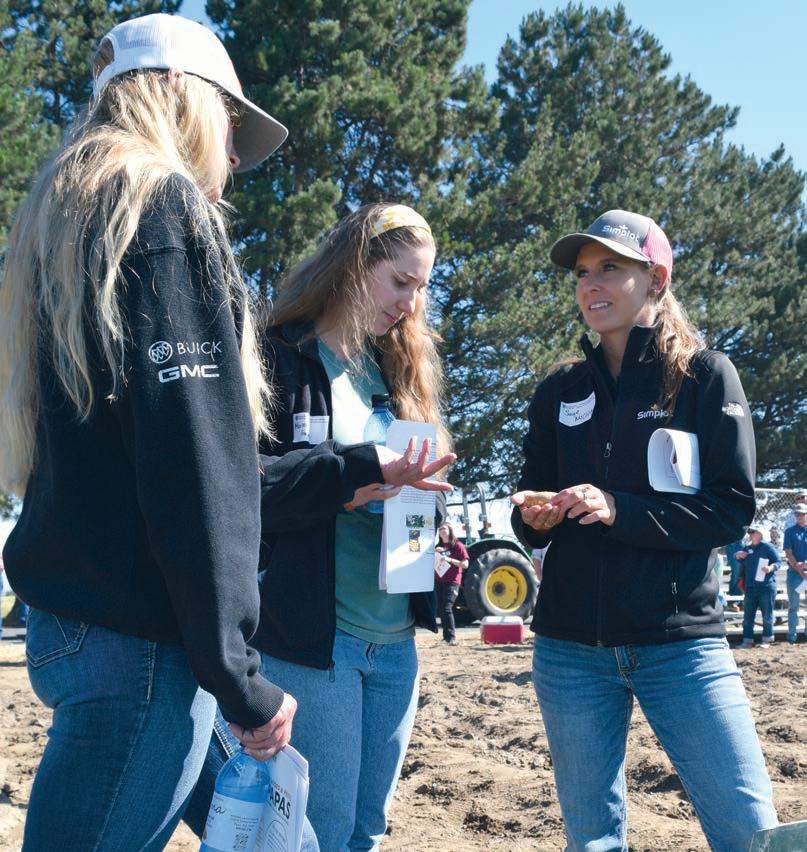
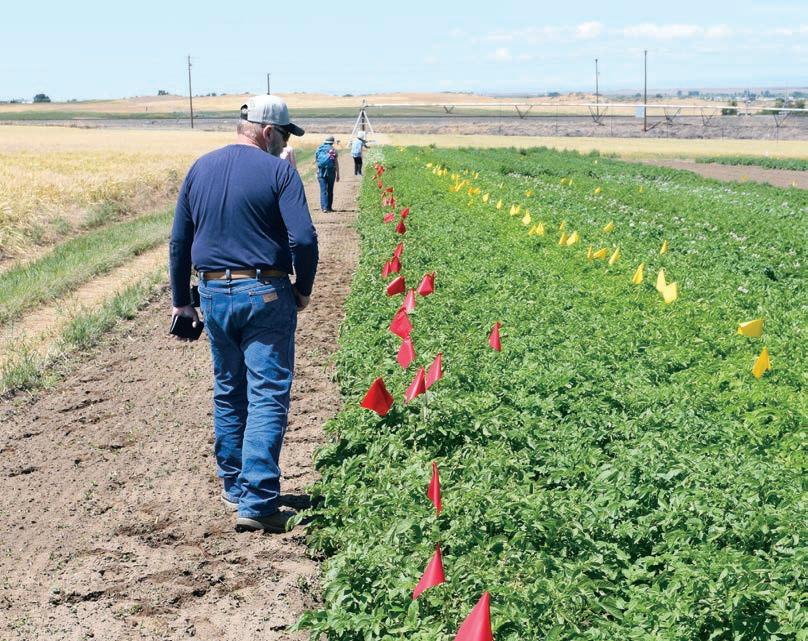
To begin her project, Moore screened 11 clones with promising resistance to powdery scab in a greenhouse and evaluated resistance or susceptibility of root systems to galling. In doing so, she observed Summit Russet, Mesa Russet and POR08BD1-3 to be highly resistant varieties and Shepody, which was included in the project as a control, to be highly susceptible.
Using a Summit Russet and Shepody cross generated by Rich Novy with USDA-ARS, Moore grew a population of progeny that have varying levels of resistance to powdery scab in a greenhouse trial, inoculated the soil and harvested the tubers. Next, Moore will evaluate phenotypes by giving each plant a disease rating, and then compare this phenotypic data with genotypic data (i.e., DNA sequence data) to find correlations between certain genetic markers and powdery scab resistance using quantitative trait locus mapping. Following this work in the greenhouse, Moore plans to grow the plants in the field with disease pressure.
8 Potato Country • September/October 2023
OSU POTATO FIELD DAY
Red flags in the OSU seed lot trial mark plants that show symptoms of blackleg.
Field day attendees discuss up-and-coming potato varieties on display.
INSECT BIOLOGY QUIZ

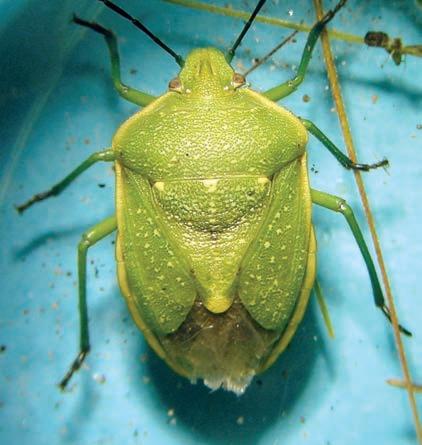

There are many pairs or groups of insects that either look similar but are not closely related or that look similar and are closely related. Such similar insects can have similar, or very different, feeding habits. The three insects pictured below are an excellent example relevant to potato. One of these is a highly desired predator of Colorado potato beetle; the others are plant feeders and can be pests in crops. All three insects are about ½-inch long.

Questions:
1. What is the general name for all three of these insects? Or for those inclined, what family do these belong to?
2. Is each one a plant-feeding potential pest or a predator?

This material is provided courtesy of Andy Jensen, Ph.D., Manager of the Northwest Potato Research Consortium. For more information, visit www.nwpotatoresearch.com. B A
Answers Page 26
PotatoCountry.com 9
PotatoCountry.com 9
C
DISEASE IDENTIFICATION QUIZ

Dr. Jeff Miller, a plant pathologist, is the president and CEO of Miller Research, Rupert, Idaho. He can be contacted by phone: (208) 531-5124; cell: (208) 431-4420; jeff@millerresearch.com

Walking through the field, you see a dead plant as shown in Photo A. When you pull up the stem to look closer, you see a blackened stem as shown in Photo B. When you cut the stem open, as shown in Photo C, the center is decayed and hollowed out.
What is this disease? And what could you do about it at this stage of the growing season? B A


Answers Page 27
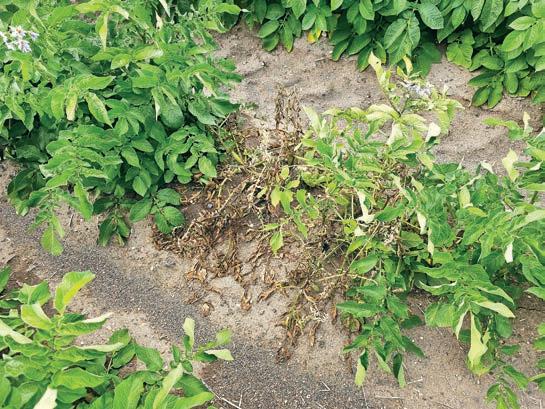
C
10
Country • September/October 2023
Potato
PILERS
1995 Double L 831 all belt 36” x 49’ ID
1986 Double L 831 all belt 36” x 49’ ID
1998 Milestone 36”x 48’ WA
1987 Spudnik 550 30” x 48’ ID
SCOOPERS
1990 Spudnik 100 24” 3ph
1982 Spudnik 100 24” 3ph
TRUCKS
1995 Ford LTL9000 CAT- 3176, 13 spd, Chalmers susp., 318,000 miles, 1995 Spudnik 2100 22’ bed Combo, New Paint ID
1982 IH 2500 Cummins NTC300, Auto Trans., Hendrickson Susp., 325,000 ID
2004 Kenworth W900 M11 Cum 350hp 15 speed Tran. Spudnik 26’ bed IN
1998 Volvo 13spd cummins 400hp Spudnik 22’ bed
BULK BEDS/BOXES/
SELF UNLOADING
1985 Logan 20B Electric 20’ ID
1997 Spudnik 2100 20’ Electric ID
1992 Spudnik 2100 20’ Electric ID
1990 Spudnik 2100 20’ Electric ID
1990 Spudnik 2100 26’ Electric IN
1986 Spudik 2000 20’ electric ID
CROSSOVERS/WINDROWERS
2018 Allan 36” bed 6 row ID
2015 Double L 6560 36” bed 6 row ID
2009 Double L 951 34” bed 4row ID
1996 Double L 851 36” bed 4 row ID
2012 Lockwood 554 36” bed 4 row ID
1984 Logan 2 row RH BC ID
2008 Spudnik 6160 36” bed 6 row R&L discharge ID
2007 Spudnik 6140 36” bed 4 row ID
2005 Spudnik 6140 36” bed 4 row
HARVESTERS
2017 Allan 3 row Electric with VFD controls PEI
2020 Double L 973 36” bed 4 row ID
2018 Double L 7340 36” bed 4 row ID
2012 Lockwood 474H 4 row ID
2009 Spudnik 6400 4 row ID
2008 Spudnik 6200 2 row multi sep PEI
2001 Spudnik 5625 36” bed 2 row ID
STINGERS
2015 Double L 832 36” BC with fingers ID
2007 Double L 833 30” Belt Chain only ID
2014 Logan Trac Pro 30” x 10’ belt only ID
1994 Spudnik 2230 36” belt only ID
CONVEYORS TELESCOPIC
2000 Double L 836 36” x 60’ 3phase ID
1996 Double L 820 30” x 60’ 3phase ID
1996 STI 30” x 70’ 3ph Tel. Conv. ID
CONVEYORS STRAIGHT
2019 Spudnik 1600 Collector Conveyor 60” x 20’x 1-42” & 2-36” belt stingers
Spudnik 1200 30” x 40’ 3ph x 4 ID
Spudnik 1200 30” x 30’ 3ph ID
Spudnik 1205 30” x 25’ 3ph ID
SIZER ONLY
2012 Mayo Sizer 60” 3phase ID
2021 Spudnik 925 84” 3phase ID
1996 Spudnik 926 72” 3phase ID
NOT COMPLETE LIST CALL OR CHECK OUR NEW SITE SPUDEQUIP.COM
DIRT ELIMINATOR WITH SIZER
1997 Double L 807 Dirt Elim. 62” BC 3ph Stingers 72” Sizer ID
2010 Milestone 60” sizing table only w/acorns quick adjust arms ID
1994 Milestone 72” Dirt Elim. Sizer, 2 – 24” x 12’ stingers WA
2011 Spudnik 96” 990 BC Elev. Reverse roll table, sizing table, split picking, cross out conv. ID
2004 Spudnik 995 DES 72” Q A Dirt & Size roll tables, split picking 230 volt 3ph. ID
2002 Spudnik 72” DE belt elev ID
DIRT ELIMINATOR ONLY
2000 Double L Model 878 80” BC hopper, fingers, BC picking table 3ph.ID
1998 Double L Model 806 BC, fingers, belt table, 2- pups 230 volt 3ph
1997 Double L 807 Dirt Elim. 62” Belt Chain feed, Urethane finger rollers, belt table, 3ph ID
2017 Milestone 96” 480 3phase WA
2021 Spudnik 925 72” 3phase ID
2006 Spudnik 995 72”Finger rollers, ellis table, Belt Chain table 230 Volt 3phase ID
1990 Spudnik 950 72” 230 volt 3phase ID
ROCK/CLOD/AIR ELIMINATORS
2013 Harriston 4240 Clod Hopper 3ph AB
2013 Harriston 3240 Clod Hopper 3ph MB
2011 Harriston 3240 Clod Hopper 3ph ID
EVEN FLOWS/ SURGE HOPPER
New Logan Surge Pro Hoppers 60” 72”
DIRT TARE PILER
2021 Spudnik 1110 30” rock rollers, chevron belt 3ph. WA
MISC.
Ace Roll over Hyd. Reset Plow 5 bottom ID
2020 Logan Barrel Washer for little potatoes CA
Belly Dump unloader attachment for Scooper ID
Evenflows: 1200 cwt, 900 cwt, 400 cwt ID

Greentronics Scale ID
Kerian 72” sizer ID
PLANTERS
2020 Checchi Magli 4 row used, but like new CA
2005 Lockwood 6 row pick planter 6 row 36” ID
2003 Kverneland 3300 cup 6 row 34” pull hitch ID
2013 Miedema 6 row 36” pull type cup planter Model CP62P MT
2013 Spudnik 8069 bed planter 9 units in 6 row pull Type ID
2008 Spudnik 8080 Pull type cup, 8 row, 36” ID
SEED CUTTERS
Better Built model 448 single phase 220 volt 48” ID
TREATERS
2016 Excel 10” liquid and dry treater 230 V 3ph ID
2002 Better Built 12” Cannon Duster ID
1991 Better Built CDT10- 8” Cannon Duster ID
WATER DAMMERS
2014 Logan 8 row Yield Pro 36” folding wings Water Dammer ID
PREMIUM USED EQUIPMENT QUICK & RELIABLE PURCHASE
PotatoCountry.com 11 BRUCE: (208)390-5120 | BRUCEN@TRISTEELMFG.COM • EVAN: (208)757-8481 | EVANN@TRISTEELMFG.COM • MAX: (701)740-7574 | MAXW@TRISTEELMFG.COM
Improving Irrigation Efficiency
Story and photos by Denise Keller, Editor
Whether concerned with drought conditions or simply striving toward good stewardship, water use efficiency continues to be a priority for potato growers. The topic topped the agenda at this year’s Washington State University (WSU) Potato Field Day, held June 22 in Othello, Washington, as WSU Ph.D. student Jacob Meeuwsen shared details of a trio of trials underway.
“All three of these projects mainly look at how to maximize water efficiency,” he said. “We’re trying to figure out how to be wiser with the water we have available to us.”
Mobile Drip Irrigation
Of particular interest to growers was Meeuwsen’s trial evaluating the use of mobile drip irrigation in potatoes. He and his advisor, Mark Pavek, are assessing the feasibility, strengths and weaknesses of mobile drip irrigation compared to conventional overhead irrigation. The Dragon-Line equipment used in the trial turns a center pivot into a mobile drip irrigation system by running drip lines down the potato rows off the irrigation drop-downs that would normally have sprinkler heads attached. Essentially, this type of system is meant to allow the
benefits of drip irrigation with the ease of overhead center pivot irrigation.

In the trial, which includes Ranger Russet, Clearwater Russet, Umatilla Russet and Russet Burbank, Meeuwsen is maintaining proper soil moisture through the use of conventional overhead irrigation in some rows and mobile drip irrigation in others.
“We expect that the plants getting the mobile drip irrigation treatment will use less water because it’s going directly to the root zone with very little water evaporating off the canopy,” Meeuwsen explained.
Drip lines extend from the irrigation drop-downs to the potato rows in this mobile drip irrigation system.
In addition to reducing water usage, mobile drip irrigation could lessen disease pressure, as keeping the plant canopy from getting wet reduces humidity and makes conditions less conducive for disease growth.
Mobile drip irrigation is used in corn, wheat and alfalfa and has been tried in potatoes in other growing regions, and it’s starting to gain traction, according to Meeuwsen.
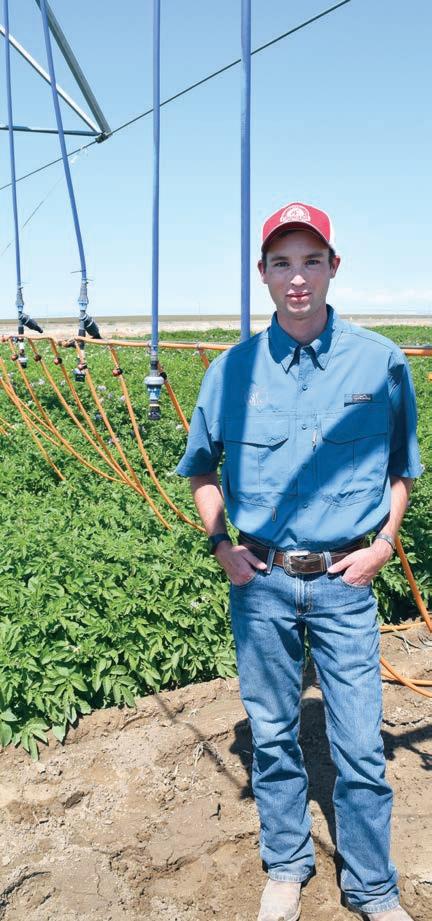



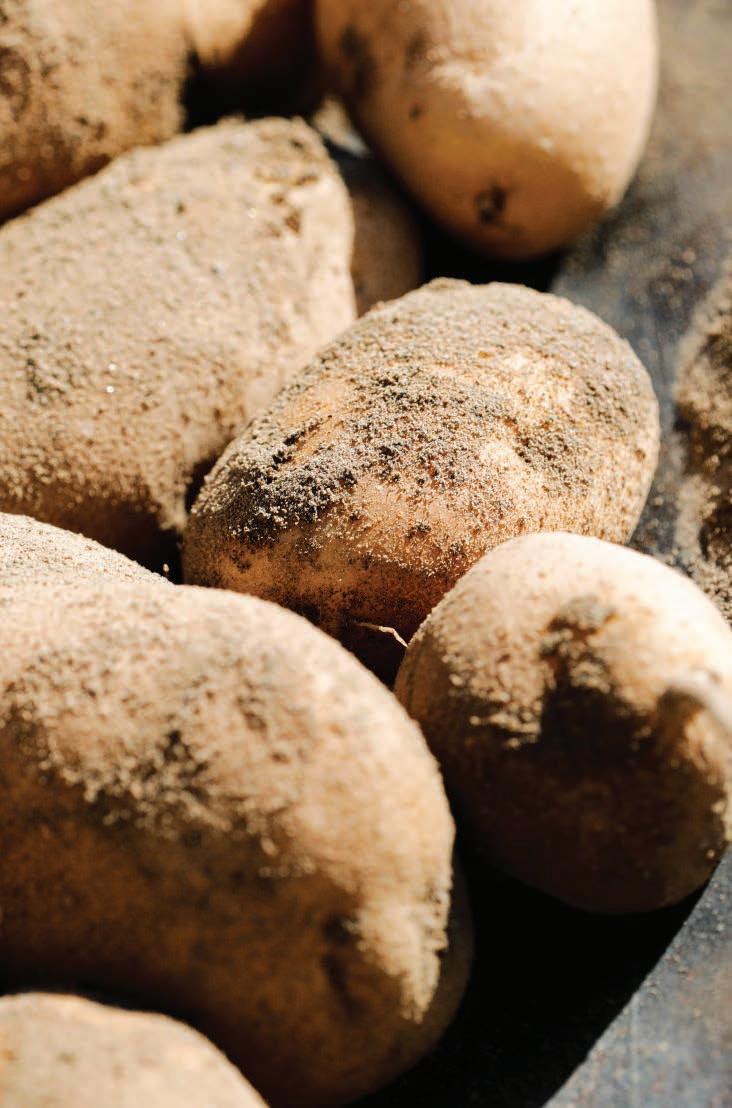
“I think it’s super cool trying this mobile drip irrigation because if it does work, it will be a great tool for growers to use even when there’s not a water shortage,” he said.
Planting Considerations
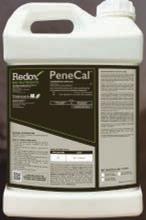





In a separate trial, Meeuwsen is studying how plant population impacts
water usage. This is the first year WSU has added a water use component to an ongoing trial on row spacing. Ranger Russet and Clearwater Russet potatoes planted at in-row spacing of 6, 9, 12 and 15 inches and at row widths of 32 and 34 inches are being irrigated at 60, 80, 100 and 120 percent of evapotranspiration (ET).
“I would expect as we see higher plant populations, the crop would use more water compared to a lower plant density,” Meeuwsen said.



















































Ultimately, data from the trial will help researchers advise growers on ideal spatial arrangements for planting during years with water restrictions or reductions. Recommendations will balance maximizing a grower’s water use efficiency and economic return on investment.
Early-Season Irrigation

The final trial looks at the effects of soil moisture deficit prior to emergence and from emergence to tuber initiation.

PotatoCountry.com 13 Scan to learn more Contact us for more information at (208) 678-2610 @redoxgrows redoxgrows.com LISTEN TO OUR REDOX GROWS PODCAST Scan the QR code to listen to our Podcast You’ve worked all season for a good potato crop, and there’s one final key step to a successful dig. Applying a small amount of PeneCal™ before vine kill provides several significant benefits. PeneCal™ boosts your soil moisture, making it more tillable, with less clods that bruise tubers. With less dirt accumulation, harvest, handling, cleaning and storage are much more efficient. The resulting improved air flow also provides a better quality potato crop.
WSU Ph.D. student Jacob Meeuwsen is working on three research trials to evaluate water use efficiency.
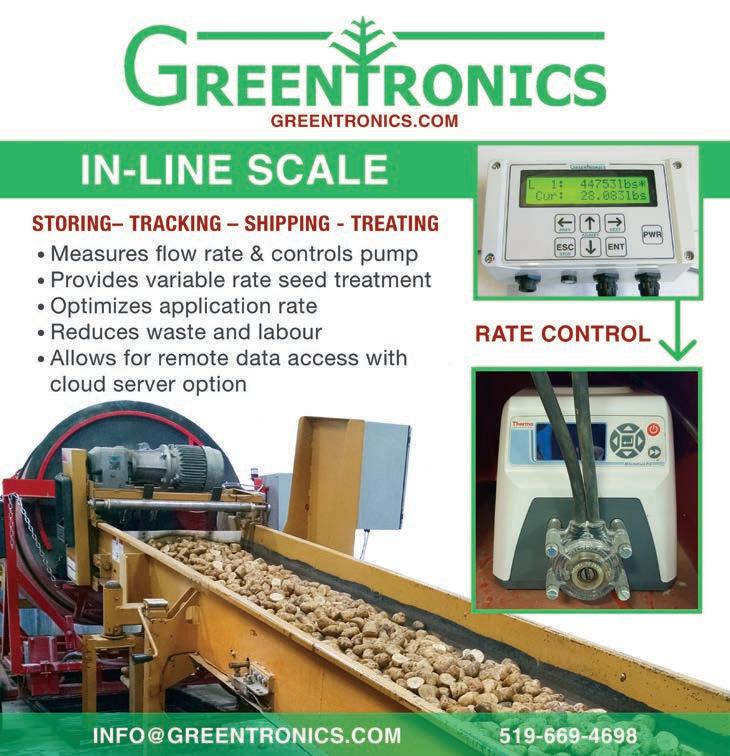


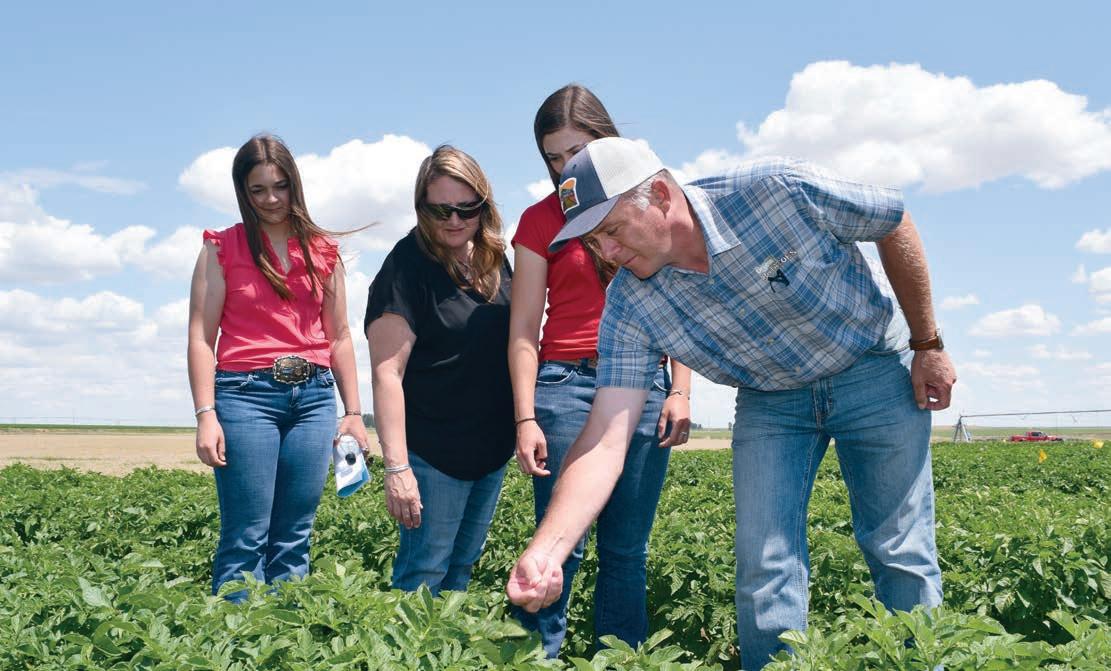
14 Potato Country • September/October 2023 Listen on: ThePotatoPodcast.com WSU POTATO FIELD DAY
Kailee, Milne, Tegan and Mike Macy check out the WSU seed lot trial.
This study stems from a thought in the industry that stressing plants early in the season results in deeper roots, which helps minimize heat stress later in the season. However, Meeuwsen pointed out, roots begin to develop before plant emergence. Therefore, not irrigating before emergence could stunt plants and reduce yield.

Ranger Russet, Clearwater Russet, Umatilla Russet and Russet Burbank plants are receiving one of three treatments: 1) a soil moisture deficit of <65 percent available soil moisture prior to emergence, then irrigated conventionally for the remainder of the season, 2) a soil moisture deficit one week after emergence, then irrigated normally for the remainder of the season, or 3) available soil moisture
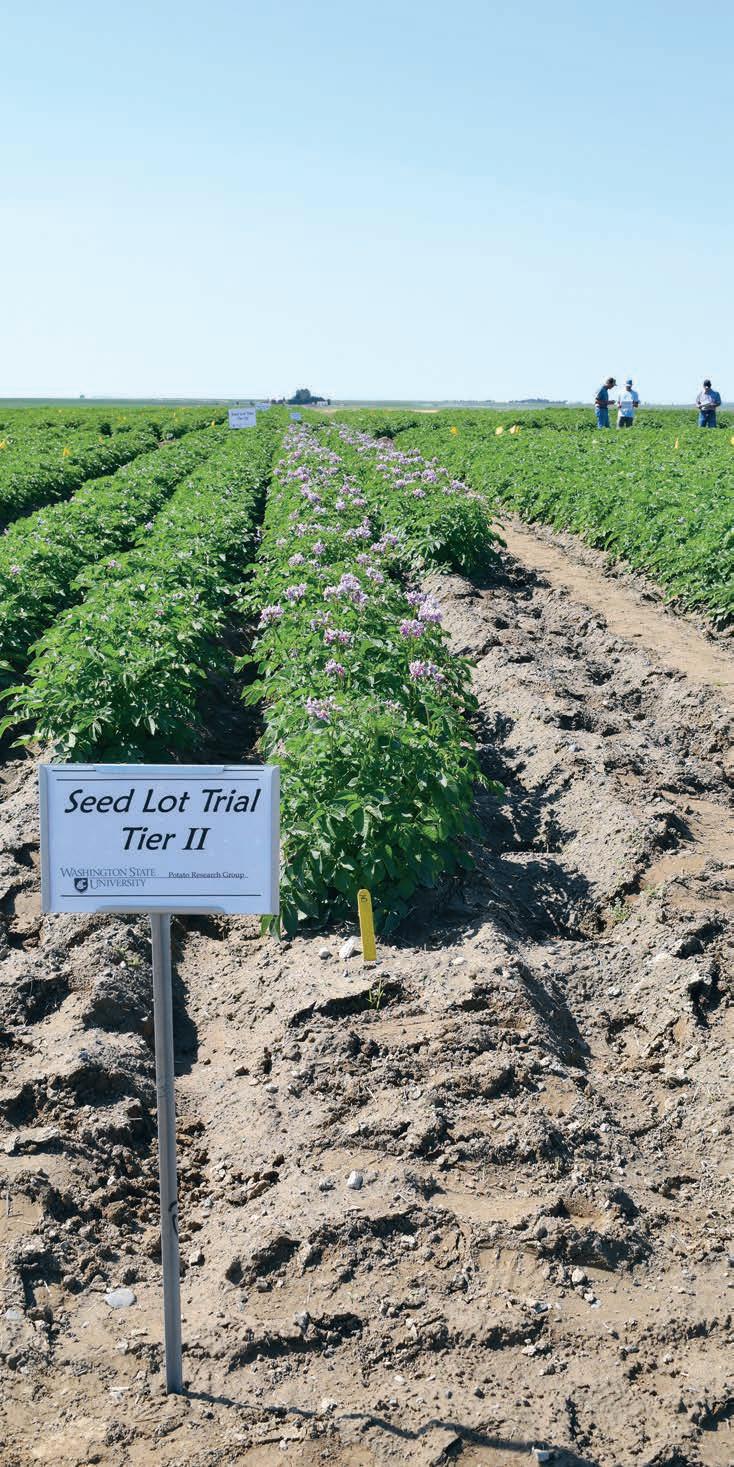
PotatoCountry.com 15
WSU’s 2023 commercial seed lot trial consisted of 255 seed lots, with 33 varieties included.
WSU researchers are assessing the feasibility, strengths and weaknesses of mobile drip irrigation in potatoes.





16 Potato Country • September/October 2023
WSU POTATO FIELD DAY
WSU researchers share data during the potato cultural management practices session at the field day.
maintained at 65-85 percent throughout the season (control treatment).

“I would expect to see that the soil moisture deficit treatments will hurt yield. Roots begin to develop before you even see the plant come out of the ground and the plants are growing so fast right at emergence that if they don’t get enough water at that time, they will be stunted for the remainder of the season,” Meeuwsen said. “I think we will be able to show growers that early-season irrigation is very beneficial to the potato crop and yield and quality at harvest.”
For each of the three trials, Meeuwsen will measure yield as well as internal and external tuber quality at harvest. He will also look at fry quality and color in the early-season soil moisture deficit trial. The team will repeat the work next year before making recommendations.

Meeuwsen and Pavek received funding for these projects from the USDA/WSDA Specialty Block Grant Program, Northwest Potato Research Consortium, Washington State Potato Commission and WSU. Dragon-Line donated the mobile drip system.
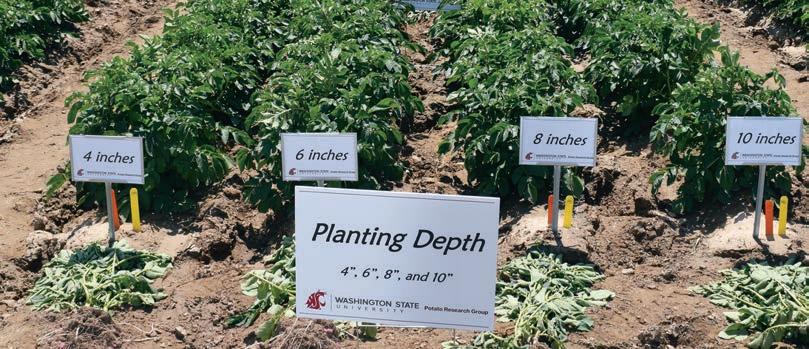

PotatoCountry.com 17
WSU Ph.D. student Jacob Meeuwsen adjusts equipment on the mobile drip irrigation system he is using in a field trial.
A field trial evaluates the effects of planting seed at depths of 4, 6, 8 and 10 inches.
Four Tips to Navigate an Unstable Fertilizer Market
 By Josh Smart
By Josh Smart
hile the global fertilizer shortage has relatively subsided, the market is now challenged with instability and uncertainty. Consequently, onion growers should not initially limited Russia’s ability to export products.
Now the supply chain is flowing more smoothly, but supply is still unpredictable. In addition, fertilizer producers’ de-carbonization efforts are also impacting production levels.
Urea capacity is forecasted to increase 2 percent in 2023 and phosphoric acid season, the more likely suppliers will run out. Here are four key strategies to help mitigate risk for your onion crops in this
Wvolatile market, as well as how to best maintain your crop yields.
Rotate your crops.
Crop rotation is a well-proven strategy for preserving healthy soil; it’s important to rotate your onion crops to other land parcels. Different varieties pull varying levels of moisture from the ground and have different root sizes, which impacts the soil over time. Further, varying produce types will affect the pH of the soil differently; healthy soil shouldn’t be too acidic or too alkaline. By rotating varieties, these factors even out, thereby improving soil health, reducing fungus attraction and increasing production.
Monitor contract pricing.
Just like managing a 401(k), it’s important
Colorado Certified Potato Growers Association
RUSSET VARIETIES:

Russet Norkotah S3
Russet Norkotah S8
Rocky Mountain Russet
Silverton Russet
Rio Grande Russet
Canela Russet
Mesa Russet
Mercury Russet





Fortress Russet
Crimson King
COLORED VARIETIES:

Columbine Gold
Colorado Rose
Rio Colorado
Red Luna
Purple Majesty
Masquerade
Mountain Rose
Vista Gold
to take an informed, long-term approach to contract pricing. Onion contracts should be carefully evaluated and then re-evaluated as time goes on. Farmers should keep their options open, for example, looking into options such as specialty crops.
Manage input costs broadly, beyond fertilizer.
Skilled crop management can reduce backfill soil costs. By considering variables such as high temperatures and drought, farmers can apply crop rotation strategies to keep soil nutrients high and fertilizer costs low.
Manage in-field threats.
Unstable fertilizer costs aren’t the only issue challenging onion growers. Timing when to spray for weeds with chemical
18 Potato Country • September/October 2023 Lorem ipsum Seed Growers: Zapata Seed Company Worley Family Farms SLV Research Center San Acacio Seed Salazar Farms Rockey Farms, LLC Pro Seed Price Farms Certified Seed, LLC Palmgren Farms, LLC Martinez Farms La Rue Farms H&H Farms G&G Farms Bothell Seed Allied Potato Colorado Certified Potato Growers Association P. O. Box 267 Monte Vista, CO 81144 Lyla@ColoradoCertifiedPotatoGrowers.com (719) 274-5996 ColoradoCertifiedPotatoGrowers.com
“Quality as High as our Mountains”
herbicide treatments is a continuous discussion if flaming isn’t being used. Destroying the seedbed of the weed before the onion seed has germinated is ideal. In addition, managing insecticide and disease control plans, as well as implementing those plans, on a regular basis also keeps growers increasingly busy.
Fluctuating prices and supply chain issues are not anticipated to resolve any time soon. Consequently, running a successful onion growing business requires planning, growing strategies and actively evaluating different financial and land cultivation strategies and options.
About the author: Josh Smart is the North American practice leader and chief sales officer for agribusiness, food and cannabis with HUB International and is responsible for leading the strategic initiatives around growing and supporting the agribusiness segment.
Nov. 8-9
Montana Seed Potato Seminar

Holiday Inn
Missoula, Mont.
www.mtseedpotatoseminar.com
Nov. 15-16
Pacific Northwest Vegetable Association Conference and Trade Show
Three Rivers Convention Center Kennewick, Wash.
Sheri Nolan, (509) 585-5460 or www.pnva.org
Jan. 10-11
Potato Expo 2024
Austin Convention Center Austin, Texas
www.potato-expo.com
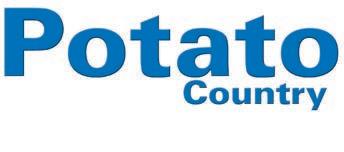
Editor’s note: To have your event listed, please email Denise Keller at editor@ columbiamediagroup.com. Please send your information 90 days in advance.

PotatoCountry.com 19
2024 Buyers' Guide is coming! Avoid FOMO! Make sure your company is listed in the Buyers' Guide. Contact us today! dave@ PotatoCountry.com brian@ PotatoCountry.com
CALENDAR
STORAGE ESSENTIALS BUYERS' GUIDE
Agri-Stor Companies
www.agri-stor.com

Specialty Crop Protection Products
For almost 60 years, Agri-Stor Company has provided expertise to growers, processors and packers. Agri-Stor markets, and custom applies, specialty crop protection products including potato sprout inhibitors, disinfectants and sanitizers. The company has turn-key application systems designed to maximize results. It also provides custom climate control systems including everything from refrigeration to ventilation and controls. With the company’s Agri-Star Control Panel and its intuitive app, customers can enjoy complete control of all aspects of their storage environment. Agri-Star’s objective is to offer solid solutions to maximize potato quality throughout the entire “life” of the harvest, from storage to packaging.
Drexel Chemical Company
www.drexchem.com

Phiticide
Phiticide is a systemic fungicide providing protection against foliar and postharvest diseases.

Forte
www.fortehumidifiers.com
Forte Humidifiers
Forte Humidifiers have proven to be a cost-effective solution for achieving ideal humidity levels in potato storages. While being offered at a fraction of the cost of the current market alternatives, Forte Humidifiers produce a superior fog quality and allow for more adaptable installations. In addition, all Forte Humidifiers have been carefully designed and constructed with materials that resist corrosion from water and acids, and thus can double as chemical applicators.

20 Potato Country • September/October 2023
GroupAg
www.groupag.com
Storage Ventilation, Post-Harvest Chemical Application
GroupAg is a full-service post-harvest company. The core of the business services includes potato storage ventilation, refrigeration and post-harvest chemical application. Proprietary application methods are efficient and effective. GroupAg can help create and maintain the ideal conditions to maximize the value of the crop through the storage and shipping processes. GroupAg offers engineering expertise to design and build storage ventilation systems with industry-leading components and can service and maintain any existing system.
GroupAg represents and distributes the following: 1,4Group chemicals, Decco chemicals, BioSafe Systems chemicals, BTU Ventilation products, Forte Humidifiers, JTS refrigeration, ATEC Indirex cooling systems and Caldwell/Chief axial fans.
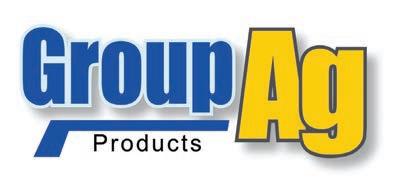
Industrial Ventilation Inc.
www.ivi-air.com
Climate Control and Ventilation Systems
Industrial Ventilation Inc. (IVI) offers state-of-the-art ventilation technology and climate control for stored potatoes. Growers turn to IVI from the ground up, from building design services to equipment systems and installation.

IVI’s Imperium control panel puts storage control right at growers’ fingertips and includes a handy mobile app. The Imperium features intuitive operation with extensive capabilities including historical data, helping users determine the best parameters for their current storage conditions. IVI service technicians understand prompt response is critical in troubleshooting solutions.
IVI’s chemical service application is rooted in years of experience. With evolving market demands – both at home and abroad, for fresh or frozen – IVI is adept at customized plans for growers’ unique needs. IVI offers a comprehensive line of application options and proven solutions to address sprout control, cut black, dormancy and more. IVI welcomes the opportunity to demonstrate its commitment to each customer’s best storage outcome and bottom line.
Restrain
www.restrain.io
Sprout Inhibitor and Seed Treatment
Restrain is the manufacturer of a unique generator that converts ethanol to ethylene gas. Based in the Netherlands, Restrain has been in Europe for over 20 years. In 2022, Restrain was approved for use in the U.S. and Canada.

Ethylene is a gaseous plant hormone involved with many physiological processes including growth regulation. It restricts the elongation of sprouts after tuber dormancy break and is the basis of the sprout inhibitor Restrain. Ethylene gas is used to prevent sprout elongation in potatoes and onions in storage. Ethylene gas is a sustainable option and a natural replacement to chlorpropham (CIPC).
Restrain also offers a seed treatment that increases stem numbers and yield by gently warming seed in storage. This has no effect on dormancy, and seed can be planted within three days of stopping treatment. The Accumulator treatment leads to more stems, a more even size distribution, increased yield and faster emergence.
PotatoCountry.com 21
STORAGE ESSENTIALS BUYERS' GUIDE
Suberizer Inc.
www.suberizer.com

Storage Facilities

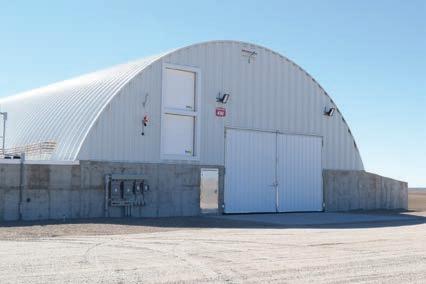
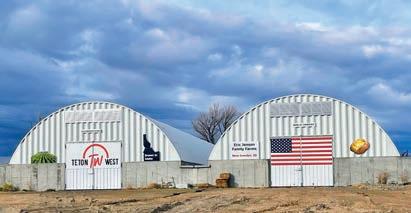
Suberizer Inc. is a second-generation construction company that specializes in designing and manufacturing raw product storage facilities. The company’s goal is to provide clients with a costeffective design that meets expectations for tomorrow’s market. Suberizer’s dedication, knowledge and experience for nearly 50 years set the company apart. Suberizer has been exposed to nearly every spectrum of the potato and onion storage market. Its team addresses everything from start to finish, including project planning, storage and building design, types of construction, civil and structural engineering, ventilation system and air distribution solutions, refrigeration systems and electrical work.
Teton West of Idaho
www.tetonwestconstruction.com
Steel Building Design and Construction

For nearly 50 years, Teton West of Idaho has proven itself time and time again as a reliable Eastern Idaho steel buildings contractor. By making large strides to implement modern building technology and processes into the way the company works, Teton West guarantees continued value to its customers. As the original dealer for Varco Pruden buildings and Meridian Manufacturing, Teton West and its trade partners promise that the company’s old-fashioned values coupled with an unmatched product will make customers’ construction experience a pleasurable experience.
Titan Steel
www.titansteelidaho.com
Storage Buildings
Titan Steel’s buildings are designed to provide maximum efficiency and convenience for produce preservation. Engineered with the latest industry standard technology, the company offers a perfect solution for producers. With third-party climate controlled systems, paired with ventilated floors or pipe, Titan Steel buildings ensure that potatoes stay fresh and in optimal condition prior to reaching consumers.
22 Potato Country • September/October 2023
WSPC Announces 2023-24 Leaders
The Washington State Potato Commission (WSPC) has elected its executive committee for the 2023-24 fiscal year. Grant Morris of Pasco has been named chair of the commission and began his one-year term on July 1. Joining him on the executive committee are Kraig Knutzen of Burlington, first vice chair; Josh Bunger of Pasco, second vice chair; Adam Weber of Moses Lake, secretary; Jordan Reed of Pasco, treasurer; and Mark Hammer of Pasco, past chair.

Potato Retail Sales See Double-Digit Increases
U.S. retail sales of potatoes increased 16.8 percent from July 2022 through June 2023, reaching $16.9 billion for the 52-week period, the highest in five years. Although volume sales were down for the year (-2.6 percent), they remain 2.5 percent above pre-pandemic levels.
Retail prices increased for all potatoes by 19.9 percent. All categories of potatoes increased in dollar sales, including frozen, up 34.8 percent, and fresh, up 16.5 percent. Russet potatoes, which make up 62 percent of all volume sales for the fresh category, saw dollar sales increase by 23.5 percent and volume decline by 3.3 percent. Russet potatoes had the biggest year-over-year price increase in the fresh category (27.7 percent).
Wisconsin Farm Expands Pack Shed
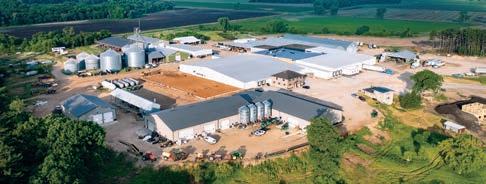

Gumz Farms is wrapping up a large expansion and remodel to its Endeavor, Wisconsin, packaging facility to better serve its customers and meet growing demand. To accommodate an average increase of 10 percent in annual sales, the expansion will increase existing capacity by approximately 40 percent. Gumz plans to complete the expansion this fall.
Owners Richard and Roderick Gumz are the fourth generation of Gumz farmers and are joined by a fifth generation, which has returned to the farm to continue building the family’s operation. Gumz Farms specializes in growing and packing potatoes and onions. Growing 40 percent of Wisconsin’s yellow onions and over 1,200 acres of potatoes, Gumz Farms is the largest producer of onions and red and yellow potatoes in Wisconsin.
Lender Predicts Profitable Returns


AgWest Farm Credit has released its quarterly Market Snapshot report covering the state of major agricultural commodities in its northern region of Idaho, Montana, Oregon, Washington and Alaska. AgWest’s 12-month outlook for potatoes suggests profitable returns for contracted and non-contracted potatoes. The report points to key drivers including increased acres to support processor expansion, ongoing contract negotiations and record russet table prices.
Vive Grows Sales Team

Vive Crop Protection Inc. continues to grow its U.S. sales team with the addition of several new regional sales managers including Nichole Drake. She will serve as the company’s Pacific Northwest regional sales manager, covering Oregon, Washington, Montana and northern Idaho.
Drake previously worked as the Crop Vitality specialist at TKI.



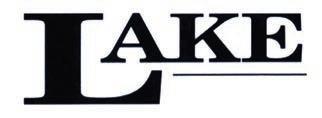
PotatoCountry.com 23 We are dedicated to providing you with consistent high quality, high yielding seed that you can depend on year after year. You are always welcome to visit our farm. Let us show you what our program can do for you. (406) 253-3638 (office), (406) 676-2175 (fax) e-mail - spudman@ronan.net Dan, Dave, Pat and Tim Lake 35822 Spring Creek Road l Ronan, MT 59864 l On-farm tissue culture laboratory and greenhouse facility for nuclear seed production l 4 year rotation on clean fields l Strict sanitation program throughout l Modern storage and handling facilities l Rigorous Spray Program PVX GIII l RUSSET BURBANK l RANGER RUSSET Tim
INTHE NEWS
Dan David David Dan Tim Pat Pat
International Marketing Efforts Build Long-Term Global Demand for US Potatoes
By Tiffany Kocir, Global Foodservice Marketing Manager, Potatoes USA
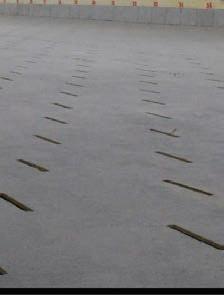


About one in five U.S.-grown potatoes is exported, creating a significant opportunity for domestic products in international markets. In addition to its marketing and research work for potatoes stateside, Potatoes USA supports the U.S. industry, along with current and potential buyers of U.S. potatoes internationally, to increase demand and get more people eating more U.S. potatoes across the globe. These international efforts keep opportunities available to the U.S. potato industry so that in the long term, U.S. potato exporters and suppliers have markets with strong demand for their products.
Educating to Create Opportunity
Education is the foundation for building long-term demand. Educating importers and distributors, the foodservice and retail trades, consumers, and government officials in international markets can help establish a preference for U.S. potato

products. All Potatoes USA international marketing programs include educational activities as a primary component, including “Why Buy U.S. Potatoes” seminars, merchandising visits, trade shows, social media marketing, culinary and nutrition workshops, technical trainings and product trials.
Reverse trade missions (RTMs) are also an effective educational tool to encourage international buyers to increase their use of U.S. potatoes. Each year, Potatoes USA hosts one or two RTMs aimed at importers and distributors, chefs, retail decision-makers or international potato growers to show potential buyers all that goes into producing high-quality U.S. potatoes. The content of each RTM is geared toward its specific audience and often includes tours of farms, processing facilities, a port, retail stores and restaurants; cold chain training; potato research presentations; meetings with the U.S. potato industry; and hands-on culinary demonstrations.
RTMs generate great results for the U.S. potato industry. In the July 2022 to June 2023 marketing year, international importers and foodservice operators began carrying over 10

24 Potato Country • September/October 2023
POTATOES USA
new U.S. potato products as a direct result of RTMs. The next RTM will be held in October with chefs from 11 target markets.
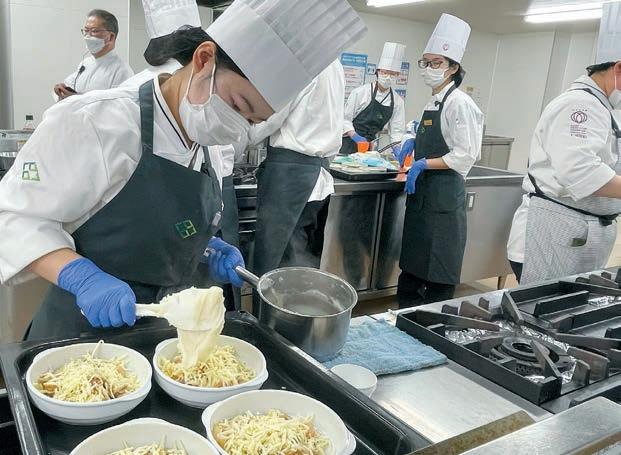

Keeping Markets Accessible




Market access work is another key piece of enabling longterm international demand. Potatoes USA works closely with the National Potato Council and Bryant Christie Inc. to monitor, respond to, and resolve any potential market access issues to ensure that the U.S. potato industry has opportunities to sell potatoes to a wide range of markets.
Building on the Marketing Mix

While education and market access are important to building and maintaining a foundational presence for U.S. potatoes, other marketing activities are added and continue to drive preference and demand for U.S. potatoes. These activities include menu development, continued outreach to trade members and promotional support. The overarching goal of all marketing programs is to establish consistent buyers of U.S. potatoes.
Potatoes USA is the marketing organization representing over 2,000 potato farms in the U.S. and promotes five main potato products: fresh table-stock potatoes, fresh chipping potatoes, seed potatoes, frozen potato products and dehydrated potato products. Potatoes USA focuses its international efforts in many of the top export markets for U.S. potatoes: Central America, China, the Gulf Cooperation Council region, Japan, Malaysia, Mexico, the Philippines, South Korea, Taiwan and Vietnam. Incountry representative agencies work alongside Potatoes USA staff to implement market-specific strategies and marketing activities.
For more information on Potatoes USA’s international marketing programs or to learn how you can get involved with these efforts, including the upcoming reverse trade mission, please contact Tiffany Kocir at tiffany@potatoesusa.com.
PotatoCountry.com 25
Chefs watch a cooking demonstration during a chef innovation session in the Gulf Cooperation Council region.
CHROME ALLOY WEAR PARTS Solving difficult wear problems! R & H Machine . 115 Roedel Ave . Caldwell, ID 1-800-321-6568 www.rhmachine.com Proudly made in the USA R & H Chrome Alloy ripper points fit most brands and models of rippers. Our points last longer, cut operating costs, save costly downtime, and maintain proper shape, penetration, and tillage.
Culinary school students participate in a hands-on training session in Japan.
R
& H also provides rollers, shakers and sprockets to fit most potato, sugar beet, garlic and tomato harvesting equipment for both hook and belted chains.
Innvictis Introduces Fungicide

Innvictis has launched a new line of fungicides that includes Innliven Elite. The dual mode of action fungicide contains pyraclostrobin with difenoconazole. Its combination of preventative and curative activity is made to control a wide range of crop diseases. In potatoes, it can be used to control black dot, brown spot, early blight, late blight, powdery mildew and Septoria leaf spot. The fungicide, which provides disease control through translaminar and systemic uptake, also improves stress tolerance and promotes plant growth, according to the company.
Visit www.innvictis.com.
Manufacturer Makes Updates to Optical Sorter

Updates to the Visar Sortop potato and carrot optical sorter are bringing increased throughput, accuracy and efficiency to potato sorting operations. Among the key updates is new software featuring infrared vision, which increases the accuracy of defect detection. In addition, the sorter features a new in-feed system, which brings an increased hourly sorting capacity. Visit www.visar-sorting.com.
KNOW YOUR INSECTS ANSWERS
(FROM PAGE 9)

1. These insects are all known as “stink bugs” and belong to the family Pentatomidae.
2. Photo A is the most common type of pest stink bug I’ve seen in potato, a member of the genus Chlorochroa. Photo B is the predator of Colorado potato beetle, the species Perillus bioculatus. Photo C is a plant-feeding stink bug I saw in a potato field in 2009. I am not sure of the species identification, which goes to show that even when relatively knowledgeable, it sometimes pays to be careful and have your insect identifications confirmed by the correct experts.
Company Designs Digital Soil Moisture Meter to be Spot On
pot
The new SpotOn Soil Moisture Meter from Innoquest is designed to facilitate effective irrigation management by providing users with continuous soil moisture measurements as well as EC (salinity) and soil surface temperature readings.
The unit includes two sets of rubber-mounted probe rods (2.4 and 1.5 inches) that resist bending in dry or rocky soil. The meter maintains accuracy without calibration as long as the rods are not bent or worn. Its ultra-high frequency (100 MHz) measuring circuit ensures accurate moisture measurements in a variety of soil types and salinity levels.
The SpotOn Soil Moisture Meter, which sells for $995, is manufactured in the U.S. and comes with a one-year warranty.

Visit www.innoquestinc.com.

26 Potato Country • September/October 2023 NEW PRODUCTS
These photos show symptoms of blackleg caused by the bacterium Pectobacterium atrosepticum (this was formerly called Erwinia carotovora subsp. atroseptica). This pathogen is carried on seed tubers and can be spread during the cutting operation. The bacteria can move up in the xylem (water-carrying cells) of the potato stems, causing the blackleg symptoms shown in Photos B and C. Blackleg is favored by cool (50-60 degrees Fahrenheit), wet soils at planting, followed by high temperatures (over 70 degrees Fahrenheit) during emergence.

When you see plants such as those in Photo A, there is nothing that can be done to save them. Foliar applications of pesticides are not effective in reducing blackleg. A related disease – aerial stem rot – has been managed by applications of copper-containing pesticides, but these products are not effective against blackleg. Blackleg is best managed by buying clean seed, planting well-suberized seed and reducing tuber damage during the planting operation.
The Potato Association of America just held its annual meeting in Prince Edward Island, Canada. Make plans to join us July 21-25, 2024, in Portland, Oregon. It is a great opportunity to learn about the latest research on all aspects of potato production.

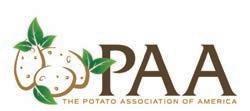



PotatoCountry.com 27
(FROM PAGE 10) Need stacking power? Do you need the ability to accumulate boxes with multiple SKUs? Scan the QR to watch our flagship machine VPM-VHV stack pallets at blistering speeds or visit verbruggen-palletizing.com Discover the ultimate potato stacking & palletizing solutions. Coming in the next issue of Planting Essentials Buyers' Guide Don’t miss this issue! Subscribe today at: potatocountry.com/ subscribe
KNOW YOUR DISEASE ANSWERS
North American Growers Expand


USDA reports that U.S. growers planted 949,000 acres to potatoes in 2023. That is 48,000 more acres than they planted a year ago, a 5.3 percent increase. Idaho’s acreage increase (+35,000 acres) accounted for 72.9 percent of the total U.S. expansion. Preliminary data from Canada show that growers in that country planted 396,922 acres to potatoes this year. That exceeded the 2022 area by 9,819 acres, a 2.5 percent increase. The combined North American potato area is 1.346 million acres, up 57,819 acres, or 4.5 percent, from the 2022 crop. Since 2020, Canadian potato acreage has expanded by 10 percent, while U.S. potato acreage increased 3.3 percent relative to 2020 levels. Overall, the total North American potato acreage is 66,600 acres more than it was for the 2020 crop.
Abandonment
USDA projects this year’s harvested potato area at 941,900 acres. That is 46,300 acres more than growers harvested in 2022, a 5.2 percent increase. A year ago, U.S. growers abandoned 5,400 acres of potatoes, 0.6 percent of the planted acreage. During the previous five years, abandonment has averaged 1.2 percent of the U.S. potato area.
Canadian growers abandoned 5,752 acres of potatoes during 2022, mostly due to heavy rainfall in the spring. That was 1.5 percent of all potatoes planted.
Abandonment during 2018 and 2019 was 5.1 percent and 5.7 percent, respectively. Before those years, abandonment has averaged about 1.4 percent of the planted area. Because there have been very few reports of abandonment so far this growing season, we have held our estimate of Canadian abandonment at 1.5 percent. Canada’s 2023 harvested area would be 390,968.
Based on these harvested acreage estimates, the combined North American 2023 harvested acreage would be 1,332,868 acres, a 4.4 percent increase from 2022 levels.
Yields & Potential Production
The U.S. long-term trend yield is 460 cwt per acre. That is up from the current estimate for last year’s poor yield, 438 cwt per acre. Using the trend yield and projected abandonment, the U.S. would be expected to produce 433.3 million cwt of potatoes during 2023. That would be 41 million cwt more than 2022 production, a 10.5 percent increase. If realized, that would be the largest U.S. potato crop since 2000.
Canada’s average potato yield has increased by about 3.4 cwt per acre per year for the past 20 years. The trend yield for the 2023 crop is 322 cwt per acre. The current estimate for last year’s crop is also 322 cwt per acre. With a trend yield and estimated abandonment, Canada would produce a 125.9 million cwt crop during 2023. That would exceed 2022 production by 3 million cwt or 2.4 percent.
North American potato production will increase substantially, given this year’s acreage expansion. Estimated abandonment and trend yields suggest that North America’s 2023 potato crop could total 559.2 million cwt. That would exceed 2022 production by 44.1 million cwt or 8.6 percent. It also would be 32.3 million cwt or 6.1 percent more than the five-year average production for the U.S. and Canada combined.
Using trendline yields and average abandonment is a good place to start estimating total production. It only takes average growing conditions to produce a trendline yield. However, there are many other factors that can and will impact production between the time I write this article and the time you sit down to read it. A lot can happen before the harvest is complete.
After a cold spring, summer growing conditions have been mostly favorable across North America. Idaho’s potato crop was planted late, but summer growing conditions have been nearly ideal. Cold spring temperatures held back crop development and yields for Washington’s early varieties. Full-season yields are expected to increase relative to last year. So far, the western states and provinces have avoided the extended heatwave that lingered through most of the growing season last year. Growers in most Canadian provinces got a head start on planting. Timely rains have improved the yield outlook in several provinces, though parts of Quebec have received too much rain. Irrigation water supplies have been tight in Alberta. Processing potatoes in that province are about seven to 10 days ahead of schedule. Considering these factors, North American potato production could end up on either side of trend yield projections.
Absorbing Extra Production From 2023 Crop
Frozen processing raw product supplies have been extremely tight as the industry transitions to the 2023 crop. French fry and other frozen product sales have been strong, despite finished product price increases. Fryers increased Pacific Northwest contract volumes for the 2023 crop. Growers in Idaho, Washington and Alberta planted nearly 47,000 more acres to potatoes than they did a year ago, a 9 percent increase. Idaho and Washington increased potato acreage by 35,000 acres
28 Potato Country • September/October 2023
MARKET REPORT
Expand Potato Acreage
and 5,000 acres, respectively. Alberta planted 6,920 more acres to potatoes this year. Contract volumes and processing acreage appear to be relatively stable in other areas. This year’s acreage increase, coupled with stronger yields, will produce a large volume of openmarket potatoes. Processors are likely to be more selective with potato quality and when purchasing production overages this year. Despite increased processing capacity, a substantial portion of those potatoes could be diverted to the dehy and table potato sectors.
Record prices have encouraged growers in Idaho, Washington and other areas to increase russet production. A return to trend yield, after last year’s challenging growing conditions, will significantly boost russet table potato supplies during the 2023-24 marketing year. In addition, Idaho’s continuing shift from Burbanks to Norkotahs could increase marketable supplies further. Growers in most Canadian provinces held their table potato acreage similar to 2022 levels. Open-market russet prices will face significant downward pressure during August and September as the harvest gets underway.
Summary
Most of this year’s extra planted acreage is for frozen processing potatoes. Several plants have expanded processing capacity, and they plan to source local raw product during the 2023-24 processing season. Raw-product supplies have constrained both domestic frozen product usage and French fry exports during the past two years. Frozen product sales are expected to increase significantly during the next 12 months. Processors could use a substantial portion of the extra production to meet increasing demand. However, extra supplies will likely be pushed onto the table potato market.
By Ben Eborn, Publisher, North American Potato Market News


KEY POINTS
• North American growers planted 4.5 percent more acres to potatoes in 2023, mostly for frozen processing.
• Increased raw-product supplies could boost frozen product sales.
• Extra russet potatoes are likely to be diverted to the table potato market.
• Open-market russet prices will come under significant downward pressure as the harvest ramps up.
Editor’s note: To contact Ben Eborn, or to subscribe to North American Potato Market News (published 48 times per year), write or call: P.O. Box 176, Paris, ID 83261; (208) 525-8397; or email napmn@napmn.com.
Agricultural Consulting & Testing

PotatoCountry.com 29
• Soil Testing
Irrigation Scheduling
Feed Analysis
Contract Research • Tissue Testing
Pest Management • Field Research • Grid Sampling • Variable Rate Fertilization • International Testing • Agronomic and CCA Seminars • Nematode Testing Contact: Paul Stukenholtz, Consulting Agronomist Crop Consultants: JP Kruckeberg • Bart Kunz • Cameron Brower Antone Christensen • Wess Gibson • Cody McCoy • Kevin Victor 208-734-3050 • 800-759-3050 PO Box 353 • 2924 Addison Ave E. • Twin Falls, ID 83301 www.stukenholtz.com
•
•
•
•
OF
WASHINGTON
Is it Time to Retire “Tired” Varieties?
 By Dale Lathim, Potato Growers of Washington
By Dale Lathim, Potato Growers of Washington

ow that we are midway through our 2023 potato harvest, I have to admit that the crop has not yielded nearly as well as I expected it to considering the great weather we had in May and June. I know the spring was abnormally cool and cloudy, which delayed emergence and development, but in years past when we had those types of springs followed by great weather in May and June, the crop caught up and we had average or above average yields. This year, however, we have been struggling to get fields to hit even the five-year average and most have been 10 to 15 percent below that.
Last year, our front half of the crop was down about the same in yield, but we
Nhad a heavier than normal set with lots of smaller potatoes. This year, the size is actually above the five-year average, but with lower than normal tuber counts, the overall yield is still coming up short.
So, yields are down for the third year in a row. In 2021, we had extreme heat in June due to a heat dome that impacted all of the Pacific Northwest. Last year, we had a mild spring and early summer and then extreme heat in August, with that month being the third hottest on record. This year, though, we have not had any extreme weather conditions; we just did not have as much sunshine and radiant heat early in the season. Many growers that I have talked with about this issue point to different suspected causes, but one consistent explanation they continue to mention is that some of our varieties just seem to be getting “tired.”
They point to the early years when
Ranger Russets consistently yielded in the high 30 tons to low 40 tons. Now we are hard pressed to get them to average above the low to mid 30 tons. Similarly, Umatilla Russet yields in the early years of its use were 15-20 percent higher than we are seeing consistently today. The Russet Burbank variety that has been around longer than any of us seems to have plateaued, but is the lowest yielding full-season variety across the Columbia Basin.
With these lower yields looking like they might be here to stay, we must look at the pricing of these varieties. As long as trend line yields were increasing each year, it was easy to adjust the contracts in line with the changes in cost of production. We have continued to do this over the past couple of years and have done a very good job of keeping prices in line with overall cost increases. However, with these lighter yields now looking like the new trend, prices will need to be adjusted to be sure that costs are fully covered and sustainable margins are being met for these older varieties.
The good thing is there are some new varieties that seem to be showing a lot of promise in terms of both yield and quality. The downside of this is that not all of these varieties have widespread approval for use in many major labels. As more restaurant chains approve these varieties and seed sources become more available, I expect we will see less of the older “tired” varieties. But this will take time and it will be many years before older proven varieties are completely eliminated. This makes addressing these yield issues an even higher priority. We will be doing all we can to solidify the profitability of the older varieties and will not overlook them as we bring in the “shiny” new ones.
30 Potato Country • September/October 2023
IN THE POTATONEWSGROWERS
Agri-Stor ..........................3 Bayer ...............................5 Colorado Seed .................18 Greentronics....................14 Industrial Ventilation .......32 Lake Seed ........................23 Montana Seed .................16 Montana Seed Seminar ...11 NovaSource .....................17 NovaSource .....................19 ADVERTISER INDEX
Potato Expo .....................31 Redox ..............................13 R&H Machine ..................25 Skone Irrigation ...............28 SpudEquip.com ...............11 Stukenholtz .....................29 Titan Steel .......................24 Telone .............................2 Verbruggen......................27






























































































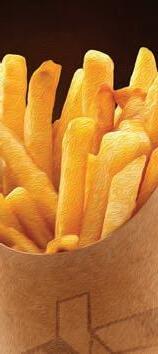


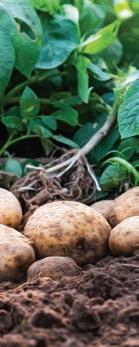






PotatoCountry.com 31 JANUARY 10-11, 2024 POTATO-EXPO.COM Register today at Brought to you by











































































 By Josh Smart
By Josh Smart



























































 By Dale Lathim, Potato Growers of Washington
By Dale Lathim, Potato Growers of Washington























































































